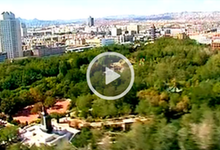Folk art: Huining shadow play
( chinadaily.com.cn )
Updated: 2013-11-29
Huining shadow play is a type of traditional Chinese opera prevailing in Huining, a county of Baiyin city, Gansu province.
According to historical research, shadow play began in the Han Dynasty (206 BC-AD 220), matured in the early Song Dynasty (960-1279), and become very popular in the Ming and Qing dynasties (1368-1911). Now it is mainly seen in southeast and central Huining, including Yangyaji, Pingtou, and other villages and towns.
Traditional Huining shadow play is unique in its forms of aria, which include Shanxi opera and percussion music. The Dengying tune is the most artistic aria with the most distinctive local characteristics. It uses various musical instruments, including stringed instruments (such as theerhuandsanxian) and wind instruments (like thesuonaand flute).
More than 300 scripts with over 140 plays now exist. The scripts, mainly passed down from old folk artists verbally and in writing, are the fruit of generations of old artists.
The themes of these plays include karma, heroism, filial piety and ethics. Shadow play is the main carrier of folk culture, a simple expression of traditional morality, and a major part of local people’s spiritual and cultural life.


